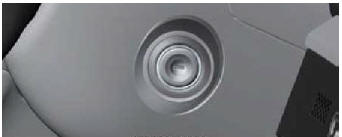Kia Sportage: Key positions
Your vehicle is equipped with four different ignition positions.
Illuminated ignition switch
Whenever a front door is opened, the ignition switch will illuminate for your convenience, provided the ignition switch is not in the ON position.

The light will go off immediately when the ignition switch is turned on. It will also go off after about 30 seconds when the door is closed.
Ignition switch position
Your vehicle is equipped with four different ignition positions.

LOCK (1)
The ignition key can be removed only in the LOCK position.
ACC (Accessory) (2)
The electrical accessories are operative.
If difficulty is experienced turning the ignition switch to the ACC position, turn the key while turning the steering wheel right and left to release the tension.
ON (3)
The warning lights can be checked before the engine is started. This is the normal running position after the engine is started.
Do not leave the ignition switch ON if the engine is not running to prevent battery discharge.
START (4)
Turn the ignition switch to the START position to start the engine. The engine will crank until you release the key; then it returns to the ON position. The brake warning light can be checked in this position.
Ignition switch
Never turn the ignition switch to LOCK or ACC while the vehicle is moving. This would result in loss of directional control and braking function, which could cause an accident.
NOTICE
If you leave the ignition switch to the ACC or ON position for a long time, the battery may discharge.
WARNING
Key holder
Do not attach small purses, multiple keys, or any other heavy accessories to the driver's key chain used to start the vehicle. This may cause the driver to accidentally make the key inserted in the vehicle to change the ignition position to the ACC position while the vehicle is moving thereby increasing the risk of an accident and causing the deactivation of several safety features.
WARNING
Leaving the vehicle
To avoid unexpected or sudden vehicle movement, never leave your vehicle if the gear is not locked in the P (Park) position and the parking brake is fully engaged. Before leaving the driver's seat, always make sure the gear is shifted to P (Park) position, set the parking brake fully and shut the engine off.
Starting the engine
- Make sure the parking brake is applied.
- Make sure the gear is shifted to P (Park) position. Depress the brake pedal fully.
- Turn the ignition switch to START and
hold it there until the engine starts (a
maximum of 10 seconds), then
release the key.
It should be started without depressing the accelerator pedal.
- Do not wait for the engine to w a rm up
while the vehicle remains stationary.
Start driving at moderate engine speeds. (Steep accelerating and decelerating should be avoided.)
WARNING
Steering wheel
Never reach for any controls through the steering wheel while the vehicle is in motion. The presence of your hand or arm in this area could cause a loss of vehicle control
If the engine stalls while you are in motion, do not attempt to move the shift lever to the P (Park) position. If traffic and road conditions permit, you may put the shift lever in the N (Neutral) position while the vehicle is still moving and turn the ignition switch to the START position in an attempt to restart the engine.
Starter
Do not engage the starter for more than 10 seconds. If the engine stalls or fails to start, wait 5 to 10 seconds before reengaging the starter. Improper use of the starter may damage it.
READ NEXT:
 ENGINE START/STOP button position
ENGINE START/STOP button position
Illuminated ENGINE START/STOP button
The light will go off after about 30 seconds
when the door is closed. It will also
go off immediately when the theft-alarm
system is armed.
ENGINE START
 Starting the engine
Starting the engine
WARNING
Do not start the vehicle with the accelerator
pedal engaged. The vehicle can
move and lead to an accident.
Wait until the engine rpm is normal.
The vehicle may suddenly move if the
SEE MORE:
 Explanation of scheduled maintenance items
Explanation of scheduled maintenance items
Engine oil and filter
The engine oil and filter should be
changed at the intervals specified in the
maintenance schedule. If the vehicle is
being driven in severe conditions, more
frequent oil and filter changes are
required.
Drive belts
Inspect all drive belts for evidence of
cuts, cracks,
 AUX (Auxiliary) Jack | Troubleshooting
AUX (Auxiliary) Jack | Troubleshooting
Schematic Diagrams
Circuit Diagram
[AUX, USB, iPod Jack]
Description and Operation
Description
The AUX, iPod and USB JACK on the center console is for customers who like to listen to external portable music players like the MP3, iPod, earphone, USB memory stick, CD player and etc
Content
- Home
- Kia Sportage - Fifth generation (NQ5) - (2022-2025) - Owner's Manual
- Kia Sportage - Second generation (JEKM) (2005-2015) - Body Workshop Manual
- Kia Sportage Third generation (SL) - (2011-2016) - Service and Repair Manual
- Sitemap
- Top articles